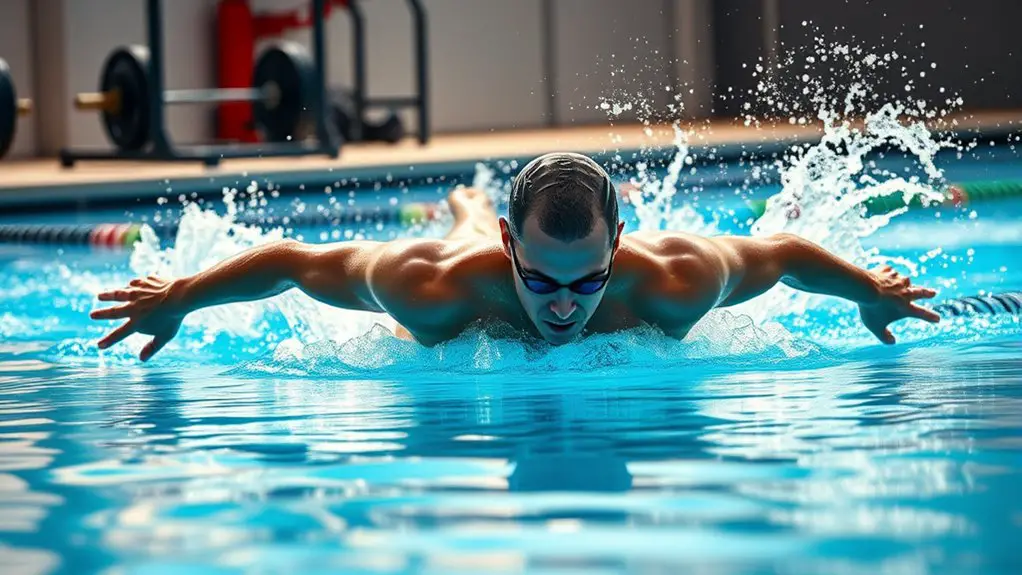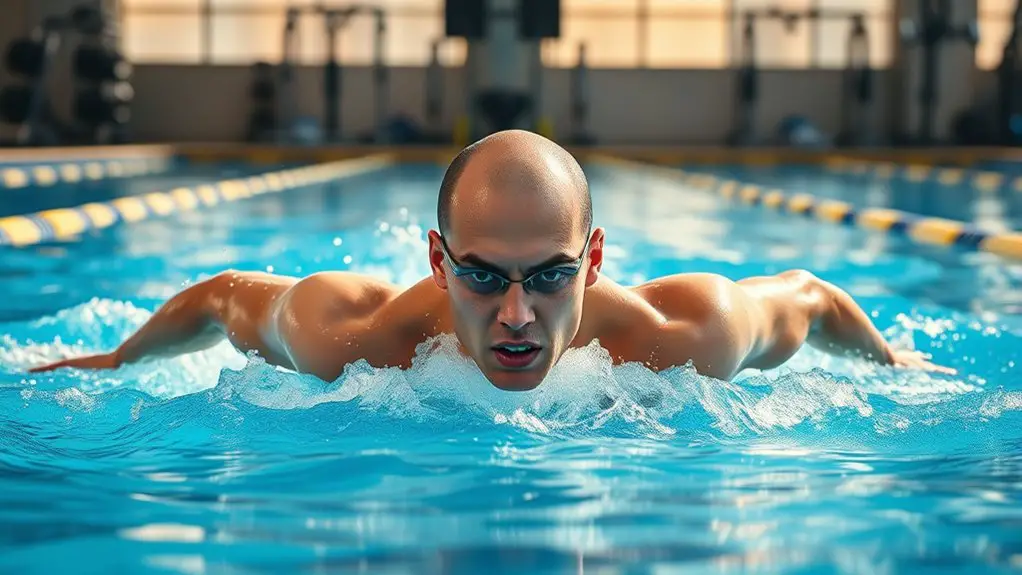How Swimming Can Improve Your Gym Performance

Swimming can greatly enhance your gym performance by improving your endurance, strength, and flexibility. It’s a low-impact workout that supports muscle recovery while alleviating soreness. Not only does it engage different muscle groups, but it also boosts your mental resilience and focus, which is essential for tackling gym challenges. Plus, it helps prevent injuries by promoting joint health. Discover how to tailor swimming workouts to meet your unique fitness goals and integrate them into your routine.
The Benefits of Cross-Training With Swimming

When you incorporate swimming into your training routine, you not only diversify your workouts but also enhance your overall gym performance. A benefit analysis of cross-training with swimming shows that it can improve your strength, flexibility, and endurance without putting excessive strain on your joints. This low-impact exercise allows you to recover while still challenging your muscles.
By focusing on various swimming techniques, such as freestyle and breaststroke, you engage different muscle groups that traditional gym workouts may neglect. This balanced approach helps prevent injuries and promotes a safer training environment. Additionally, swimming can enhance your body awareness and improve your coordination, which translates into better form during weightlifting or other gym activities.
Incorporating swimming into your routine isn’t just about physical gains; it’s also about providing a rejuvenating mental break from the usual grind, making your fitness journey more enjoyable.
Enhancing Cardiovascular Health Through Swimming
Swimming not only complements your gym workouts but also plays an essential role in enhancing your cardiovascular health. By regularly incorporating swimming into your routine, you can greatly improve your cardiovascular endurance, which is critical for overall heart health. The low-impact nature of swimming makes it a safe option for people of all fitness levels, helping to strengthen your heart without putting undue stress on your joints.
Here’s a quick look at the benefits of swimming for your cardiovascular health:
| Benefits of Swimming | Description |
|---|---|
| Improves Circulation | Enhances blood flow throughout the body. |
| Low-Impact Exercise | Gentle on joints while providing a solid workout. |
| Increases Stamina | Builds endurance for longer workouts. |
| Aids Recovery | Helps in muscle recovery after gym sessions. |
| Boosts Mood | Releases endorphins, improving your overall well-being. |
Make swimming a consistent part of your fitness journey for better heart health!
Building Strength and Muscle Endurance

Swimming isn’t just great for your heart; it also helps build strength and muscle endurance. When you engage in this full-body workout, you enhance muscle activation while improving your cardiovascular capacity. Plus, the low-impact nature of swimming can increase your recovery speed, allowing you to hit the gym harder and more frequently.
Enhanced Muscle Activation
Although many people focus solely on weightlifting for building strength, incorporating swimming into your routine can greatly enhance muscle activation and endurance. When you swim, different muscle groups engage through various swim techniques, promoting balanced development. Each stroke requires coordinated movements, which activates your muscles in unique ways that traditional lifting may not achieve.
Improved Cardiovascular Capacity
Incorporating swimming into your fitness routine not only enhances muscle activation but also greatly boosts your cardiovascular capacity. When you engage in swimming, you’re performing an effective cardio workout that elevates your heart rate and strengthens your heart and lungs. This type of endurance training improves your aerobic fitness, allowing you to push through longer gym sessions with ease. Plus, swimming is low-impact, reducing the risk of injury while still offering a solid workout. As your cardiovascular capacity increases, you’ll notice enhanced stamina during high-intensity exercises, making it easier to build strength and muscle endurance. So, consider adding swimming to your regimen; it’s a safe, effective way to elevate your overall fitness levels and gym performance.
Increased Recovery Speed
As you add swimming to your routine, you may find that your recovery speed improves considerably. Swimming acts as an effective form of active recovery, allowing your muscles to recover without the strain of high-impact exercises. The buoyancy of water reduces stress on your joints, promoting safe movement while enhancing blood circulation. This increased circulation aids in muscle regeneration, helping to repair and rebuild the tissues you worked hard to strengthen at the gym. Furthermore, the rhythmic nature of swimming helps reduce muscle soreness, making it easier for you to bounce back from intense workouts. By incorporating swimming into your regimen, you’ll not only enhance your performance but also support your body’s natural recovery processes, keeping you safer and stronger in the long run.
Improving Flexibility and Mobility

Swimming’s a fantastic way to boost your flexibility and mobility, allowing for an enhanced range of motion in your workouts. As you glide through the water, you’ll notice improved joint stability that translates to better performance in the gym. This added mobility not only helps prevent injuries but also optimizes your overall strength training.
Enhanced Range of Motion
When you plunge into swimming, you might notice an impressive boost in your flexibility and mobility, which are essential for overall gym performance. Aquatic exercises engage multiple muscle groups, allowing your body to stretch and adapt in ways that land-based workouts might not. By incorporating dynamic stretches before swimming, you can further enhance your range of motion, making your movements more fluid and efficient.
| Dynamic Stretches | Aquatic Exercises |
|---|---|
| Arm Circles | Water Jogging |
| Leg Swings | Aqua Pilates |
| Torso Twists | Kickboard Drills |
| Hip Openers | Resistance Band Work |
| Ankle Rolls | Swim Stroke Variations |
These practices not only promote flexibility but also help prevent injuries, ensuring you stay safe while improving your performance.
Joint Stability Benefits
Building on the increased flexibility gained from swimming, you’ll also experience significant improvements in joint stability. As you glide through the water, your muscles and ligaments engage in ways that promote strength and control around your joints. This enhanced joint stability is essential for injury prevention, especially when shifting to weightlifting or high-intensity workouts at the gym. When your joints are stable, they’re less likely to experience strain or injury during those demanding exercises. Plus, swimming strengthens the muscles supporting your joints, helping you maintain proper alignment and balance. Incorporating swimming into your routine not only boosts your overall fitness but also creates a solid foundation for safe, effective gym performance. Embrace the benefits and keep your workouts injury-free!
Aiding in Muscle Recovery
Although gym workouts can leave your muscles feeling sore and fatigued, incorporating swimming into your routine can greatly aid in recovery. The buoyancy of water reduces impact on your joints, making it an ideal environment for gentle movement. Swimming acts as a form of water therapy, helping to alleviate muscle soreness and promote blood circulation. This increased circulation delivers essential nutrients to your muscles, speeding up the healing process.
As you glide through the water, you’re also engaging in low-intensity exercise, which helps prevent stiffness without overexerting yourself. The cool water can soothe inflammation and help lower your body temperature, providing additional comfort after intense workouts. Swimming not only helps you recover faster but can also keep you motivated to stay active. By embracing swimming as part of your recovery routine, you’ll enhance your overall gym performance while prioritizing safety and well-being.
Reducing the Risk of Injury
Incorporating swimming into your fitness routine not only aids recovery but also plays a notable role in reducing the risk of injury. This low-impact exercise promotes joint health, allowing you to strengthen muscles without putting undue stress on your body. By enhancing flexibility and building endurance, swimming can be an essential part of your injury prevention strategy.
| Benefit | Description | Emotion |
|---|---|---|
| Joint Health | Keeps joints lubricated | Relief |
| Muscle Strength | Builds strength without strain | Confidence |
| Flexibility | Increases range of motion | Freedom |
Including swimming in your regimen helps you maintain a balanced approach to fitness. You’ll find that with improved joint health and overall strength, your chances of sustaining injuries during gym workouts decrease considerably. Prioritize safety—your body will thank you!
Boosting Mental Toughness and Focus
Swimming can greatly boost your mental toughness and focus, enhancing your overall gym performance. As you glide through the water, you’re not just working your body; you’re also engaged in focus training. The rhythmic nature of swimming helps you develop mental resilience, allowing you to push through physical challenges more effectively.
By concentrating on your breathing and stroke technique, you learn to quiet distractions and sharpen your mind. This focus translates to your gym workouts, where staying mentally engaged is essential for achieving your goals.
Additionally, the calming properties of water can help alleviate stress, creating a mental space where you can build confidence. When you face tough sets at the gym, you’ll find that the mental toughness gained from swimming makes it easier to stay committed and push through challenges. Ultimately, swimming can be a powerful tool in enhancing your mental game, leading to better overall performance.
Tailoring Swimming Workouts to Your Fitness Goals
Tailoring your swimming workouts to align with your fitness goals can make a significant difference in your overall progress. By focusing on specific swimming techniques and workout variations, you can enhance your gym performance safely.
| Fitness Goal | Swimming Techniques | Workout Variations |
|---|---|---|
| Endurance | Freestyle and backstroke | Long-distance swims |
| Strength | Butterfly and breaststroke | Sprints and interval training |
| Flexibility | Dolphin kicks and glides | Drills with fins |
| Weight Loss | Continuous laps | Circuit training in water |
To achieve your goals, it’s essential to incorporate a mix of these techniques and variations. For instance, if building endurance is your aim, focus on longer swims with less rest. Remember, always prioritize safety by warming up before diving in and listening to your body throughout your workouts.
Integrating Swimming Into Your Weekly Routine
To get the most out of swimming, it’s important to create a weekly swim schedule that complements your gym workouts. Incorporating swimming as cross-training can boost your overall performance and enhance recovery while improving flexibility. Let’s explore how to effectively weave swimming into your fitness routine.
Weekly Swim Schedule
Integrating swimming into your weekly routine can elevate your gym performance markedly. Start by setting aside at least two to three days for swimming sessions. Focus on varying your workouts to keep things interesting and effective. For example, dedicate one day to mastering swimming techniques, like freestyle or breaststroke, ensuring you maintain proper form to prevent injuries. On alternate days, incorporate interval training—switching between fast and slow laps—to boost your cardiovascular fitness. Don’t forget to include rest days for recovery, as this balance is essential for safety and progress. By aligning your swim schedule with your gym workouts, you’ll not only enhance your strength and endurance but also promote overall health and well-being.
Cross-Training Benefits
While you might think of swimming as just a relaxing pastime, it can actually serve as a powerful cross-training tool that enhances your overall gym performance. By integrating swimming techniques into your weekly routine, you’ll improve cardiovascular endurance and strength, benefiting your primary workouts. Here are some effective cross training strategies:
| Day | Activity | Duration |
|---|---|---|
| Monday | Lap Swimming | 30 mins |
| Wednesday | Technique Drills | 20 mins |
| Friday | Freestyle Intervals | 30 mins |
| Saturday | Recovery Swim | 40 mins |
| Sunday | Rest or Light Stretching | – |
Incorporating swimming into your schedule keeps your workouts safe and balanced, ensuring you stay injury-free while maximizing performance.
Recovery and Flexibility
Swimming not only builds strength and endurance but also plays an essential role in recovery and flexibility. It’s a fantastic way to incorporate active recovery into your routine, allowing your muscles to unwind while still engaging them gently. By swimming regularly, you can enhance your flexibility techniques, making your workouts more effective and reducing the risk of injury.
- Feel the soothing water embrace your body.
- Experience relief from muscle tension with each stroke.
- Discover newfound freedom in your movement.
- Enjoy the invigorating change of pace from your usual gym routine.
Integrating swimming into your weekly regimen not only promotes healing but also keeps you limber, ensuring you stay safe and healthy as you push your limits in the gym.
Real-Life Success Stories: Athletes Who Swim for Performance
Many athletes have discovered that adding swimming to their training regimen can lead to impressive gains in their overall performance. Swimming athletes often report increased endurance, improved muscle recovery, and enhanced flexibility, all of which contribute to performance enhancement in their primary sports.
Here are some real-life examples of athletes who’ve made swimming a part of their training:
| Athlete | Sport |
|---|---|
| Michael Phelps | Swimming |
| LeBron James | Basketball |
| Serena Williams | Tennis |
These athletes know swimming’s low-impact nature allows for effective training without stressing their joints. They also appreciate how it supports cardiovascular health and muscle balance. By integrating swimming, you might find yourself lifting heavier or running faster—without the risk of injury that comes with high-impact training. So, consider diving into the pool for your next performance boost!
Frequently Asked Questions
How Often Should I Swim to See Gym Performance Improvements?
To see improvements in your gym performance, aim for swimming at least two to three times a week. This swimming frequency allows your body to adapt while minimizing the risk of overtraining. Monitor your performance metrics, like strength and endurance, to gauge progress. Always listen to your body—if you feel fatigued, take a rest day. Balancing swimming with gym workouts can enhance overall fitness and keep you safe as you train.
Can Swimming Replace My Regular Cardio Workouts?
Yes, swimming can replace your regular cardio workouts, and it offers unique benefits. It’s a low-impact exercise, reducing the risk of injury while still providing an excellent cardiovascular workout. Swimming engages multiple muscle groups, improving strength and endurance. However, if you’re considering it as a cardio alternative, make sure you’re incorporating different strokes to target various muscles effectively. Just listen to your body, and don’t hesitate to mix in other forms of cardio for variety.
What Swimming Strokes Are Best for Cross-Training?
Did you know that swimming can burn up to 500 calories an hour? When it comes to cross-training, freestyle is fantastic for building endurance and enhancing your aerobic capacity. Meanwhile, incorporating butterfly technique works your upper body and core, offering a full-body workout. Always make certain you’re using proper form to avoid injuries. Mixing these strokes into your routine not only keeps things interesting but also optimizes your overall fitness safely and effectively.
Do I Need to Be a Good Swimmer to Benefit?
You don’t need to be a great swimmer to enjoy the swimming benefits. Even basic swimming techniques can enhance your fitness. Focusing on your form and gradually building your skills will guarantee you stay safe in the water. Just remember to start slow, listen to your body, and consider swimming as a low-impact workout. With time, you’ll see improvements in your strength and endurance, making it a valuable addition to your routine.
How Long Should My Swimming Sessions Be for Optimal Results?
You won’t believe how transformative a good swim can be! For ideal results, aim for session durations of 30 to 60 minutes, three to four times a week. This frequency helps your body adapt without overwhelming it, ensuring you stay safe while reaping the benefits. Listen to your body—if you’re feeling fatigued, it’s okay to adjust. Consistency combined with proper technique is key to revealing your true potential in the water!





